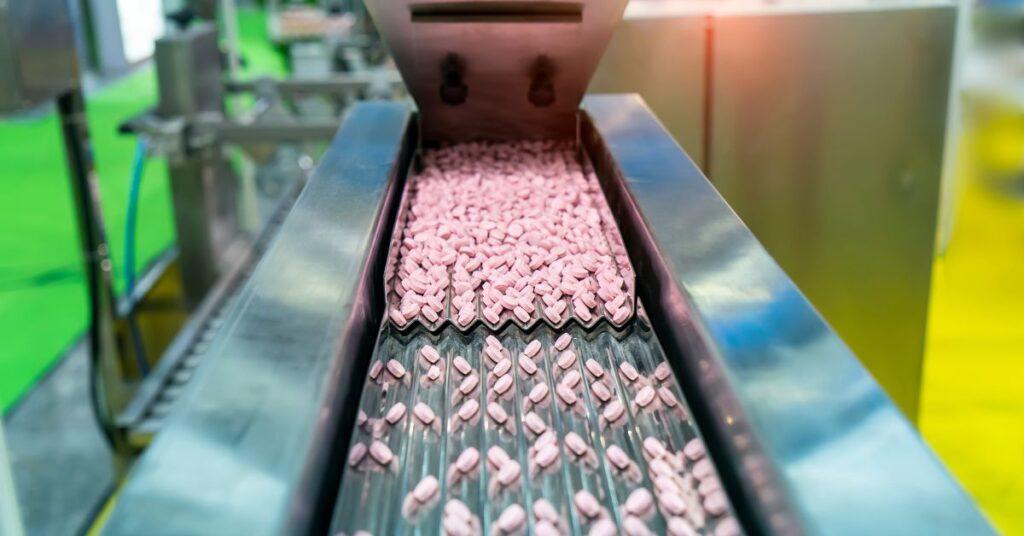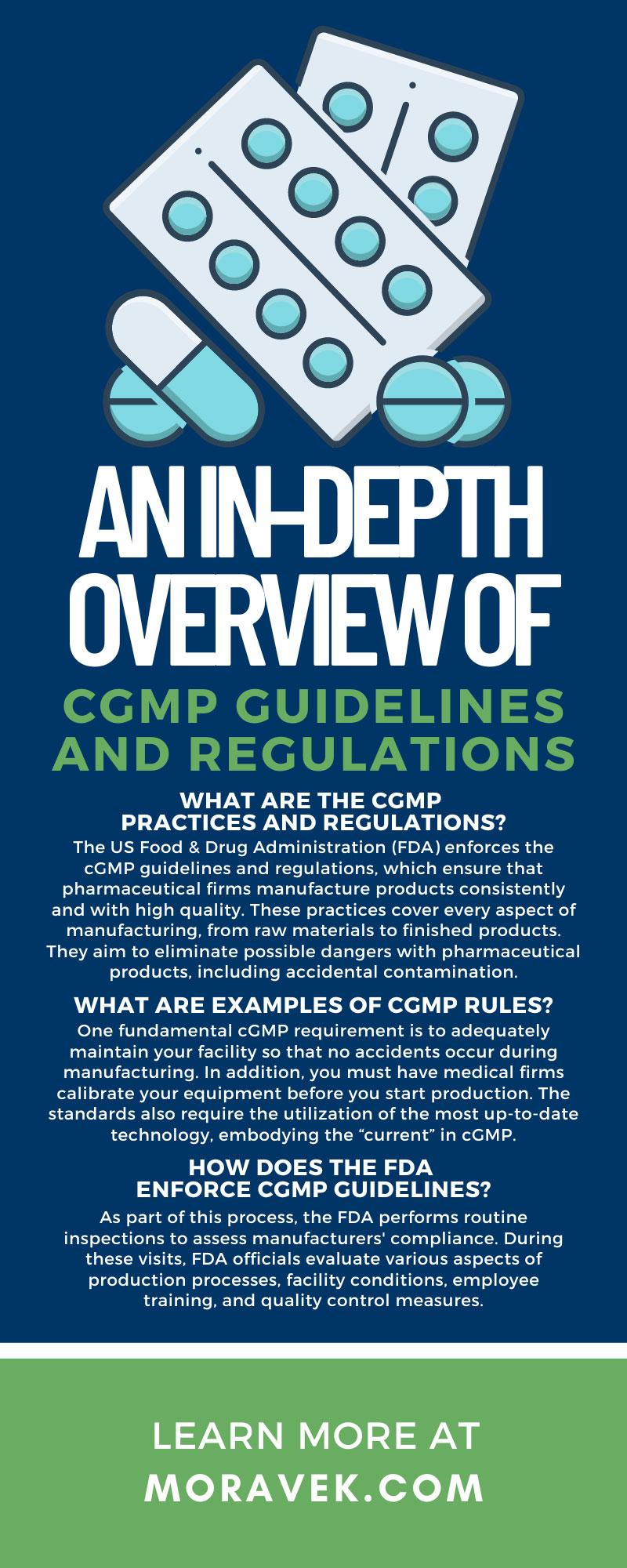
Every day, pharmaceutical firms must maintain high quality and safety standards. One way that they can do that is by following the Current Good Manufacturing Practices (cGMP) guidelines and regulations. If you are unfamiliar with this set of rules and what they involve, this blog can help. Continue reading for an in-depth overview of this set of standards and how your firm can stay aligned with them.
Read more: An In-Depth Overview of cGMP Guidelines and RegulationsWhat Are the cGMP Practices and Regulations?
The US Food & Drug Administration (FDA) enforces the cGMP guidelines and regulations, which ensure that pharmaceutical firms manufacture products consistently and with high quality. These practices cover every aspect of manufacturing, from raw materials to finished products. They aim to eliminate possible dangers with pharmaceutical products, including accidental contamination.
By adhering to cGMP guidelines, pharmaceutical manufacturers can guarantee that their products are safe, pure, and effective. These regulations require that the companies perform trustworthy testing, implement strict quality control measures, and pursue any quality anomalies within their operations.
What Are Examples of cGMP Rules?
As you align your business with cGMP standards, you should learn about some of its most important rules. One fundamental cGMP requirement is to adequately maintain your facility so that no accidents occur during manufacturing. In addition, you must have medical firms calibrate your equipment before you start production. The standards also require the utilization of the most up-to-date technology, embodying the “current” in cGMP.
Additionally, cGMP rules mandate that manufacturers conduct thorough testing of raw materials to ensure that all ingredients meet the specified quality attributes before using them. Furthermore, maintaining detailed records of production processes, quality checks, and any deviations encountered is essential in demonstrating compliance during regulatory inspections.
Finally, cGMP emphasizes the importance of employee training to ensure all employees have expert knowledge about their company’s manufacturing procedures. Companies are also responsible for providing additional training when these processes undergo updates.
How Does the FDA Enforce cGMP Guidelines?
After reading an overview of cGMP guidelines and regulations, you may wonder, “How does the FDA enforce them?” The administration takes a systematic approach to ensure pharmaceutical manufacturers adhere to these stringent standards.
As part of this process, the FDA performs routine inspections to assess manufacturers' compliance. During these visits, FDA officials evaluate various aspects of production processes, facility conditions, employee training, and quality control measures.
In addition to routine inspections, the FDA may conduct for-cause inspections in response to specific concerns, such as consumer complaints, product recalls, or adverse event reports. Should the FDA identify deficiencies during these inspections, it can employ a range of enforcement tools.
For example, it may issue a warning letter after observing violations and expect manufacturers to rectify the issues promptly. If the non-compliance is egregious or persistent, the FDA may pursue more severe actions, including imposing fines or seeking criminal charges against the manufacturers.
Some firms have created their own quality assurance practices to ensure they will meet the FDA’s standards. By fostering a culture of compliance, pharmaceutical companies can mitigate the risk of enforcement actions and enhance their operational standards, ultimately safeguarding public health.
How Are These Separate From GMP Rules?
Even if you were unfamiliar with cGMP rules, you may have heard of Good Manufacturing Practices (GMP). This may have prompted you to wonder, “Aren’t they the same?” While both aim to ensure the quality and safety of pharmaceutical products, there is a fundamental difference between the two.
GMP refers to guidelines that provide a framework for manufacturing processes. However, these guidelines are relatively static and do not change frequently. On the other hand, cGMP incorporates the concept of “current” into the guidelines.
This distinction requires manufacturers to continually evaluate and improve their processes to incorporate the latest best practices. By doing so, they can maintain cGMP-regulated facilities that benefit consumers by providing safer and more effective products.
How Can My Business Benefit by Following the cGMP Rules?
Adhering to cGMP guidelines requires pharmaceutical manufacturers to make a significant investment. This may make you wonder how else your business can benefit by following these standards, aside from avoiding legal action and fines.
First and foremost, your compliance ensures the safety and quality of your products, which will enhance consumer confidence. Furthermore, following cGMP guidelines can lead to operational efficiencies and cost savings in the long run.
By implementing robust processes and quality control measures, you will reduce the odds of errors and product failures. Compliance also demonstrates a commitment to ethical practices and corporate responsibility, fostering trust among consumers, regulatory authorities, and investors. Adherence to the cGMP rules can give you a substantial edge in your competitive sector.
How Can I Ensure My Business Is Compliant?
Ensuring compliance with cGMP guidelines requires a proactive and systematic approach. One step involves establishing a comprehensive quality management system (QMS) that integrates cGMP principles into every aspect of the business. This includes developing and regularly updating SOPs, conducting thorough training programs for personnel, and establishing quality assurance and control positions.
Regular internal audits and inspections are crucial to identifying gaps or non-compliance issues. These audits should assess all aspects of manufacturing, including facility conditions, equipment maintenance, documentation practices, and adherence to SOPs. Any identified issues should be promptly addressed through corrective and preventive actions.
Implementing documentation practices is essential for cGMP compliance. All manufacturing activities, testing results, and quality control procedures must be accurately recorded and maintained. This documentation provides a traceable record of all operations and is essential for regulatory inspections and audits.
Engaging with external experts and consultants can also be beneficial in ensuring compliance. These professionals can provide valuable insights, conduct independent audits, and offer guidance on best practices and regulatory updates.
Additionally, investing in technology and automation can further enhance your compliance efforts. Automated data collection, process monitoring, and document management systems can improve accuracy, reduce human error, and ensure real-time compliance with cGMP guidelines.
Now that you are more aware of cGMP guidelines and regulations, you can put your company on the path to being more compliant. You can also put yourself in a better position by using trusted companies like Moravek, which offers GMP 14c API manufacturing services. We maintain a quality system and perform audits so that you can have peace of mind knowing that your business meets industry guidelines.

